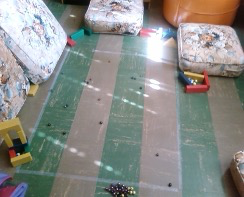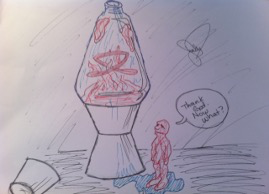Before there was “empirical” support for the use of play in therapy, and long before the discipline was formally established, play’s clinical value was broadly recognized. And the value of play as an important element of human development dates to antiquity. The notion of Homo Ludens (man, the player) captures, at least for me, the idea that play is an intrinsic characteristic of humanity. Interested readers can sample offerings from the International Journal of Play Therapy and the American Journal of Play.
But I digress! My purpose in writing this essay stems from a friend and fellow clinician’s recent dream about an (as yet perhaps) unwritten book with the title, “Existential Questions Children Would Ask.” It immediately brought me to the mental intersection of play and existentialism, which was only a short distance from the idea of play therapy qua existential therapy (I’ve always wanted to use the word qua in my writing!). Interestingly, and going briefly back to the realm of empiricism, it is child/client-centered play therapy (CCPT) that has received the most empirical support of all modes of play-based treatment.
What about this particular form of Play Therapy has attracted so much clinical attention and held up so well under the bright light of empirical scrutiny? I think it is because this particular form of intervention capitalizes upon and provides fertile clinical space for the expression and core existential concerns and existential practice. But first, a quick look at CCPT.
If we consider that these core elements of child-centered play therapy align quite nicely with the basic benefits of free, or unstructured play in general, it makes sense that this mode of intervention has historically enjoyed widespread use while also withstanding the harsh and often fickle winds of empirical scrutiny. As such, it is, based on my experience, the ideal existential laboratory, or playground, in which children—of all ages— a can express, address, and work on, and occasionally through some of their deepest concerns that they might not otherwise recognize, acknowledge or talk about. When these children come to us, it is usually at the behest of their teachers and/or parents who can’t quite understand why their child is aggressive, sad, unregulated, or any number of other behaviorally expressed concerns.
Irvin Yalom identified four core existential challenges that clients (and non-clients) experience throughout their lives. For Yalom, freedom, with its promise of limitlessness and choice can also be threatening, as it taps into a fundamental fear of loss of structure and foundation. Isolation, not to be confused with independence or autonomy, is about feeling alone and disconnected from the world of people. When meaning is perceived as a linearly navigated destination rather than a circuitous and often confusing journey, the traveler often wearies, wanders, and worries their whole life. And finally, and in every sense of the word, death as a final frontier, leaves so many clients fearful, un-completed, and regretful. Paraphrasing Yalom, many of us don’t take the loan of life (live fully) for fear of the ultimate payment, which is of course, death.
If we now think of the client- (or child-)centered play therapy as a space created for and with the child that satisfies Axline’s criteria, then that space becomes an existential laboratory in which the client, with the clinician’s agenda-free guidance, is free to explore those four elements of existence.
While he wanted the freedom to choose both goals, Josiah believed that pathways to both were distinct and that he could not pursue one until the other was accomplished. The freedom to choose was blocked by the structural mental barrier he created. I asked him to show me the challenge in the sand tray, and his depiction appears in the figure below. Through our play in the sand tray and other creative-expressive media, Josiah took down the invisible barrier he built that separated the two goals he sought along his path to freedom.
.png)
Devon was eight when his parents brought him to me for occasional aggressive behavior towards his younger sister. A strong academic student, sociable child, and typically loving family member, his behavior seemed to change soon after the death of his grandfather. Overcome with grief, Devon’s parents struggled to open family conversations around their deceased patriarch. As a man who had held such a prominent place in the family, the grandfather had literally disappeared from their lives. Devon’s attempts to ask or speak about his grandfather were met with resistance and confusing dismissals. Devon began lashing out at home and at school.
Our play took many forms, but Devon particularly gravitated to an old-fashioned game of marbles, one that he had learned from his grandfather. He set up difficult obstacles and goals for himself as the “shooter,” often becoming frustrated when his shot missed its intended mark. In one particular round of marbles, Devon decided to seek some heavenly inspiration, so to speak. He named his shooting marble, the biggest one on the floor, the “grandfather marble.” Almost at once, his accuracy improved as he moved effortlessly around the floor, skillfully guiding the marbles to their destinations—with the help of his “grandfather marble.” I did not feel the need to literalize the metaphor of the grandfather marble, although Devon began talking about his beloved grandpa. Conversations began to open in the family, and Devon’s aggressive behavior, its roots finally exposed, diminished, and both he and his family began sharing their feelings and stories about their lost loved one.

Micah, age six, was small for her age, and very shy, both at home, but particularly at school where she was occasionally bullied by one of the “bigger kids.” She would often come home crying and began resisting going to school in the morning. Her sleep was also increasingly affected. When she did go to school, she would keep to herself on the playground and rarely initiate conversation or play with others. As much as she wanted to interact, Micah became increasingly isolated. When the parents finally found out the details of the bullying, they took swift action, and changes were made at the school.
As with Devon, Micah’s play took many forms including art and dollhouse play; however, she particularly liked building solid structures out of blocks into which she would hide a particular toy car. The structures were elaborate and impenetrable, and once erected, remained so for the balance of each of our meetings. I did not want to impose my words or thoughts on Micah, but instead gave her the time and space to play through what I thought was the need to build protective enclosures for their small vehicular inhabitants. As we built and rebuilt these bastions, we talked of safety, danger, fear, and courage. And as the bullying stopped, and as weeks of play passed, and with the support of her parents, Micah took down the walls once and for all and freed their inhabitants from their previously protective isolation.

Sianna was soon to leave adolescence behind, hopefully with a greater sense of purpose and self than had characterized her earlier years. She never quite fit in, nor did she seem to want to. Perhaps she did, at a deeper level, but she seemed quite content being alone with her art. Through her drawings, both on paper and her skin, Sianna expressed both frustrations over and wonder about what lay ahead. She had the sense that her purpose lay beyond traditional education, but no clear sense of what that was or would be. While she found art to be a meaningful endeavor, she was not quite sure how to channel it into a sense of purpose.
I enjoyed Sianna’s drawings, which she readily shared as she discussed the challenges of being in this no-person’s-land on the doorstep to whatever would come next. She seemed to lack a coherent sense of self beyond her drawings. I had a wonderful lava lamp in my office during our work together, which was always percolating during our sessions. One day, she brought in this image, which said it all. Finally freed from the inchoate mass of bubbling lava from which it sprang, this little formless creature looked back at its previous entrapment and said, “Thank God, now what!?” That said it all for her, and I felt no need to impose interpretation.

Questions for Reflection and Discussion
What are your impressions of the author’s connection between CCPT and existential therapy?
What existential concerns have you noticed in the play of your young clients?
How do you address these concerns when they are expressed through play?
File under: Musings and Reflections, Child & Adolescent Therapy
Like what you are reading? For more stimulating stories, thought-provoking articles and new video announcements, sign up for our monthly newsletter.
But I digress! My purpose in writing this essay stems from a friend and fellow clinician’s recent dream about an (as yet perhaps) unwritten book with the title, “Existential Questions Children Would Ask.” It immediately brought me to the mental intersection of play and existentialism, which was only a short distance from the idea of play therapy qua existential therapy (I’ve always wanted to use the word qua in my writing!). Interestingly, and going briefly back to the realm of empiricism, it is child/client-centered play therapy (CCPT) that has received the most empirical support of all modes of play-based treatment.
What about this particular form of Play Therapy has attracted so much clinical attention and held up so well under the bright light of empirical scrutiny? I think it is because this particular form of intervention capitalizes upon and provides fertile clinical space for the expression and core existential concerns and existential practice. But first, a quick look at CCPT.
Child Centered Play Therapy as an Existential Laboratory
Virginia Axline described eight cornerstones of her approach to play therapy, She believed that the therapeutic space for children should be a safe one, grounded in acceptance, warmth, freedom of expression, and patience with and respect for their capacity to make choices and solve problems.If we consider that these core elements of child-centered play therapy align quite nicely with the basic benefits of free, or unstructured play in general, it makes sense that this mode of intervention has historically enjoyed widespread use while also withstanding the harsh and often fickle winds of empirical scrutiny. As such, it is, based on my experience, the ideal existential laboratory, or playground, in which children—of all ages— a can express, address, and work on, and occasionally through some of their deepest concerns that they might not otherwise recognize, acknowledge or talk about. When these children come to us, it is usually at the behest of their teachers and/or parents who can’t quite understand why their child is aggressive, sad, unregulated, or any number of other behaviorally expressed concerns.
Irvin Yalom identified four core existential challenges that clients (and non-clients) experience throughout their lives. For Yalom, freedom, with its promise of limitlessness and choice can also be threatening, as it taps into a fundamental fear of loss of structure and foundation. Isolation, not to be confused with independence or autonomy, is about feeling alone and disconnected from the world of people. When meaning is perceived as a linearly navigated destination rather than a circuitous and often confusing journey, the traveler often wearies, wanders, and worries their whole life. And finally, and in every sense of the word, death as a final frontier, leaves so many clients fearful, un-completed, and regretful. Paraphrasing Yalom, many of us don’t take the loan of life (live fully) for fear of the ultimate payment, which is of course, death.
If we now think of the client- (or child-)centered play therapy as a space created for and with the child that satisfies Axline’s criteria, then that space becomes an existential laboratory in which the client, with the clinician’s agenda-free guidance, is free to explore those four elements of existence.
Exploring the Four Existential Dimensions through Play
Josiah was a young adult who had long struggled with the physical and emotional challenges of a congenital illness that factored heavily into the decisions he had to make as he left adolescence behind. Finally free of the many demands college made of him, he weighed the choices ahead with a sense of gravitas. He wanted a career and a long-term intimate relationship but had so parsed them in his mind that having both seemed impossible.While he wanted the freedom to choose both goals, Josiah believed that pathways to both were distinct and that he could not pursue one until the other was accomplished. The freedom to choose was blocked by the structural mental barrier he created. I asked him to show me the challenge in the sand tray, and his depiction appears in the figure below. Through our play in the sand tray and other creative-expressive media, Josiah took down the invisible barrier he built that separated the two goals he sought along his path to freedom.
.png)
Devon was eight when his parents brought him to me for occasional aggressive behavior towards his younger sister. A strong academic student, sociable child, and typically loving family member, his behavior seemed to change soon after the death of his grandfather. Overcome with grief, Devon’s parents struggled to open family conversations around their deceased patriarch. As a man who had held such a prominent place in the family, the grandfather had literally disappeared from their lives. Devon’s attempts to ask or speak about his grandfather were met with resistance and confusing dismissals. Devon began lashing out at home and at school.
Our play took many forms, but Devon particularly gravitated to an old-fashioned game of marbles, one that he had learned from his grandfather. He set up difficult obstacles and goals for himself as the “shooter,” often becoming frustrated when his shot missed its intended mark. In one particular round of marbles, Devon decided to seek some heavenly inspiration, so to speak. He named his shooting marble, the biggest one on the floor, the “grandfather marble.” Almost at once, his accuracy improved as he moved effortlessly around the floor, skillfully guiding the marbles to their destinations—with the help of his “grandfather marble.” I did not feel the need to literalize the metaphor of the grandfather marble, although Devon began talking about his beloved grandpa. Conversations began to open in the family, and Devon’s aggressive behavior, its roots finally exposed, diminished, and both he and his family began sharing their feelings and stories about their lost loved one.

Micah, age six, was small for her age, and very shy, both at home, but particularly at school where she was occasionally bullied by one of the “bigger kids.” She would often come home crying and began resisting going to school in the morning. Her sleep was also increasingly affected. When she did go to school, she would keep to herself on the playground and rarely initiate conversation or play with others. As much as she wanted to interact, Micah became increasingly isolated. When the parents finally found out the details of the bullying, they took swift action, and changes were made at the school.
As with Devon, Micah’s play took many forms including art and dollhouse play; however, she particularly liked building solid structures out of blocks into which she would hide a particular toy car. The structures were elaborate and impenetrable, and once erected, remained so for the balance of each of our meetings. I did not want to impose my words or thoughts on Micah, but instead gave her the time and space to play through what I thought was the need to build protective enclosures for their small vehicular inhabitants. As we built and rebuilt these bastions, we talked of safety, danger, fear, and courage. And as the bullying stopped, and as weeks of play passed, and with the support of her parents, Micah took down the walls once and for all and freed their inhabitants from their previously protective isolation.

Sianna was soon to leave adolescence behind, hopefully with a greater sense of purpose and self than had characterized her earlier years. She never quite fit in, nor did she seem to want to. Perhaps she did, at a deeper level, but she seemed quite content being alone with her art. Through her drawings, both on paper and her skin, Sianna expressed both frustrations over and wonder about what lay ahead. She had the sense that her purpose lay beyond traditional education, but no clear sense of what that was or would be. While she found art to be a meaningful endeavor, she was not quite sure how to channel it into a sense of purpose.
I enjoyed Sianna’s drawings, which she readily shared as she discussed the challenges of being in this no-person’s-land on the doorstep to whatever would come next. She seemed to lack a coherent sense of self beyond her drawings. I had a wonderful lava lamp in my office during our work together, which was always percolating during our sessions. One day, she brought in this image, which said it all. Finally freed from the inchoate mass of bubbling lava from which it sprang, this little formless creature looked back at its previous entrapment and said, “Thank God, now what!?” That said it all for her, and I felt no need to impose interpretation.

***
Like most other forms of contemporary play therapy, client-centered work carries with it no assumptions other than freedom to express, freedom from judgment, and freedom from scripted technique. As such, clients are encouraged to work on the deeper existential issues related to freedom, isolation, meaning, and of course, death. It doesn’t rush, it doesn’t judge, it doesn't impose, nor does it rely on specific agenda, per se, other than the play therapist’s presence, patience, attention, and caring. These four case snippets and their accompanying images nicely demonstrate that, at least for me, this unhurried form of intervention is in many ways an existential playground.Questions for Reflection and Discussion
What are your impressions of the author’s connection between CCPT and existential therapy?
What existential concerns have you noticed in the play of your young clients?
How do you address these concerns when they are expressed through play?
File under: Musings and Reflections, Child & Adolescent Therapy






